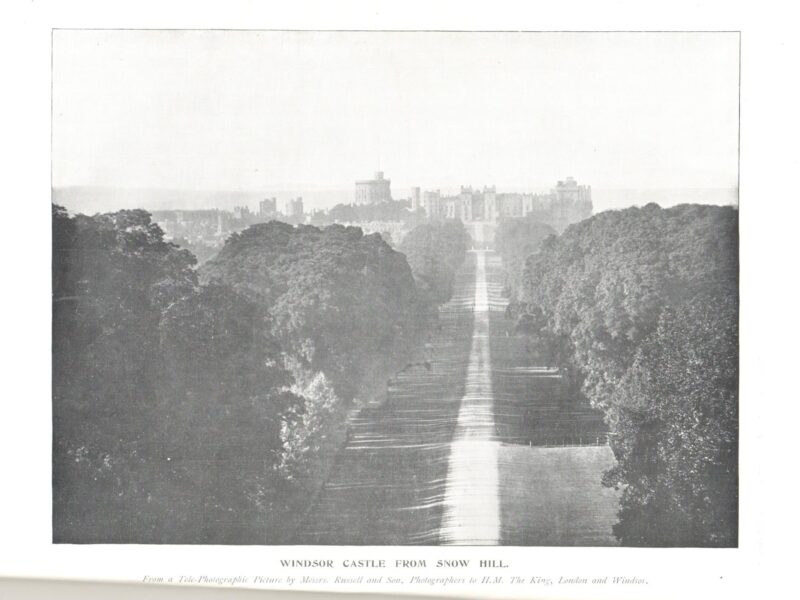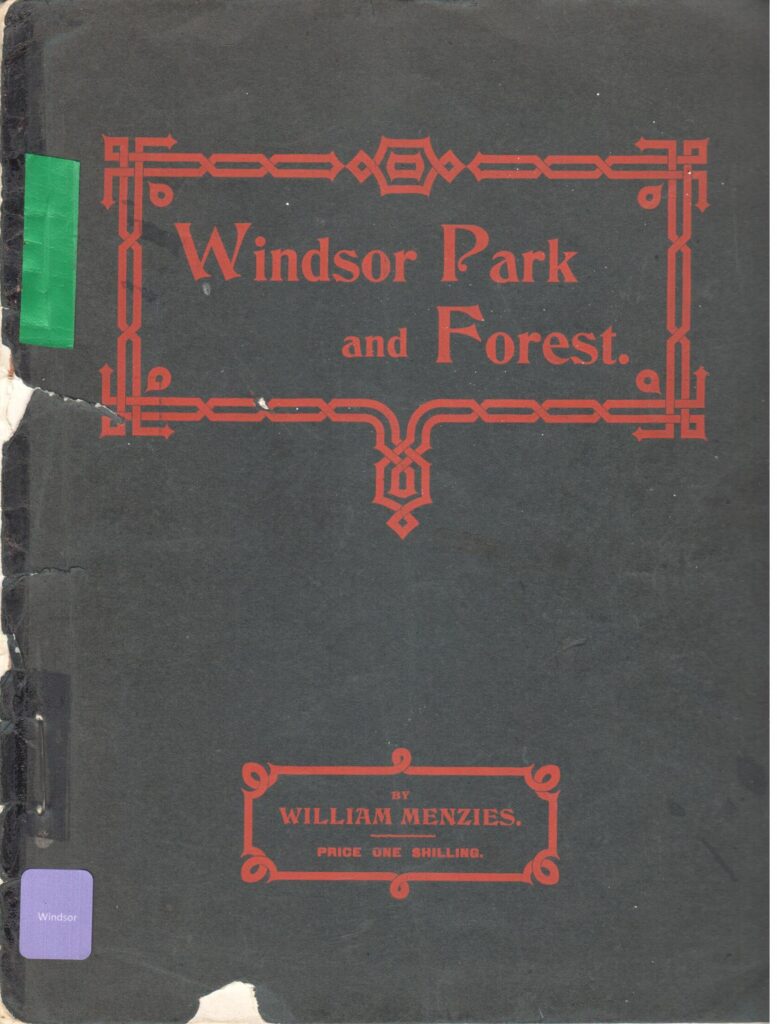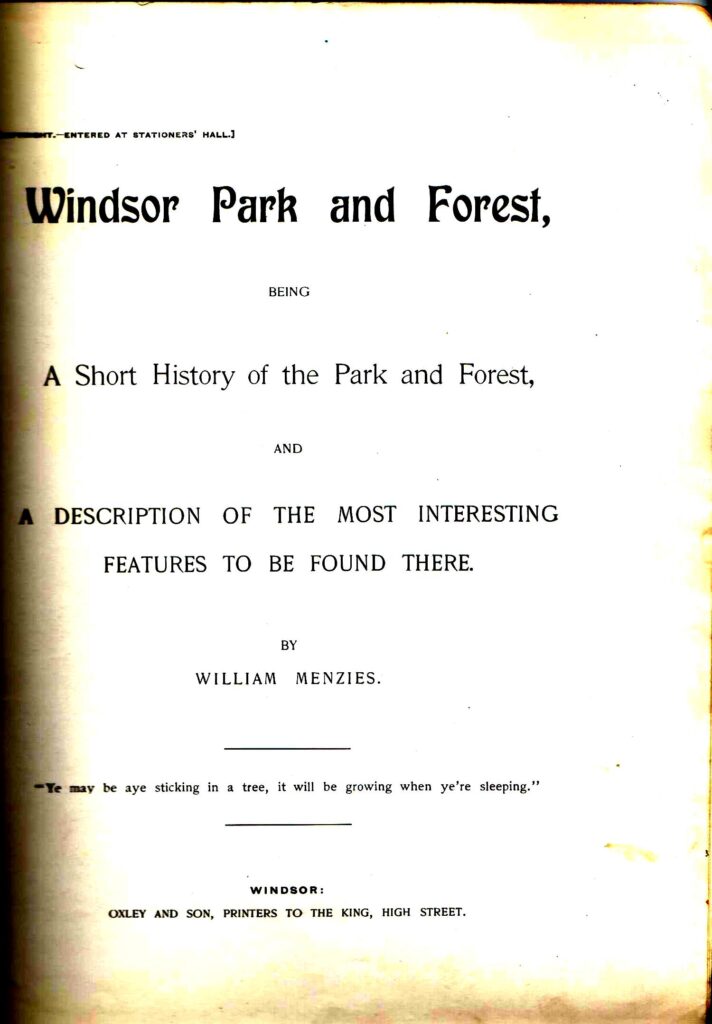Just Williams Part 9 – some of the Victorian tradesmen who shaped Egham High Street and Englefield Green
This short series of articles by Margaret Stewart has been looking at some of the businesses which began trading in Egham during the Victorian era and continued for over 50 years. There were similar businesses away from the centre of Egham itself and in the surrounding areas. What they have in common is that they were all begun by men called William…
9. William Menzies, Deputy Surveyor of Windsor Great Park and William Menzies, architect and surveyor, Bishopsgate
William Menzies was born in 1828 in Lanarkshire, Scotland, the son of William Menzies, a land agent or steward, and his wife Janet, nee Davidson. They seem to have moved to Edinburgh by 1841 where young William, interested in pursuing the same line of work as his father, must have studied to become an architect/surveyor. At the age of just 21 in 1849 he obtained the post of Deputy Surveyor of Windsor Great Park and moved to Bishopsgate, sharing accommodation at Parkside, Wick Lane, with his younger cousin David Wishart.
As Deputy Surveyor he answered to the Ranger of Windsor Great Park – Prince Albert from 1841-1861 and then Prince Christian of Schleswig Holstein (Queen Victoria’s son-in-law) from 1867-1917. He was considered to be an Officer and served as the local representative of the Commissioners of Land Revenue. Duties included communicating “from time to time with the Deputy Ranger, to inform him of such trees as are proper to be cut down, also of such plantations as are required to be thinned.”[i]
He worked alongside the Deputy Rangers, Sir William Fremont (1830-50) followed by Major General Francis Seymour (1850-70).
In 1851 he was involved in surveys and researches enabling the valuation of the Royal Forests of England. He said that “the results of these proved so interesting, that, after having ascertained all that was immediately required, I was led to carry on those which related to Windsor.” [ii]
This was to lead to his compiling the first history of Windsor Great Park, one of the first published books incorporating photographic plates, 20 in all on albumen silver print.

[https://creativecommons.org/licenses/by/4.0/ Getty Museum Collection. Accessed 25 January 2024 at https://www.getty.edu/art/collection/person/104SVQ]
This book contained a chapter on local geology, including soil quality, and his later publications [iii]showed that he became an expert on drainage systems and sewage management as well as on trees, eventually turning his attention from Windsor and its environs to the problems faced in a city like Glasgow. This last was possibly at then invitation of J. B. Russell, Glasgow’s Medical Officer of Health, who was aware of the link between well-managed sewage disposal and the prevention of disease.
In 1856 William Menzies married a fellow Scot, Margaret Emmeline Simmonds. They were joined at Parkside by young assistants who he trained to become land agents. Margaret’s younger brother Frederick, another architect, also came to live with them.
William and Margaret went on to have two sons, William Menzies Junior (1858) and Victor Schroder Menzies (1869). However William did not live to see them grow up – he died in 1878 at the age of 50. His executors were Frederick Simmonds who became Deputy Surveyor in his stead and George Menzies (possibly a cousin) of Trentham in Stafford, a land agent to the Duke of Sutherland. Frederick Simmonds took over the dwelling at Parkside. Margaret and William Junior, who had also become an architect, continued to live with him until at least the 1880s; as soon as he was old enough Victor was sent to Sunningdale School. Eventually Margaret moved to Kensington but, after she died in 1918, she was buried in Egham, close to her husband.
Victor inherited his father’s interest in trees and joined the department of the conservator of forests in northern India. Sadly he died in 1893 of enteric fever while on board a Navy ship, the Serapis. His effects, worth just £5, went to his mother.
William Jr married Jeannette Louis in 1884 and they moved to Surbiton to live with her mother. They had two 2 children, William Kenneth (1888) and Ronald Victor (1895) named for his late uncle. At some time between 1899 and 1901 they moved to a house in Middle Hill, Englefield Green, which they called Golspie after the Scottish town where the family may have originated, and William Jr worked locally as an architect and surveyor and Inspector of nuisances.[iv] His most significant architectural commission appears to have been the design for the Cottage Hospital in St Jude’s Road.

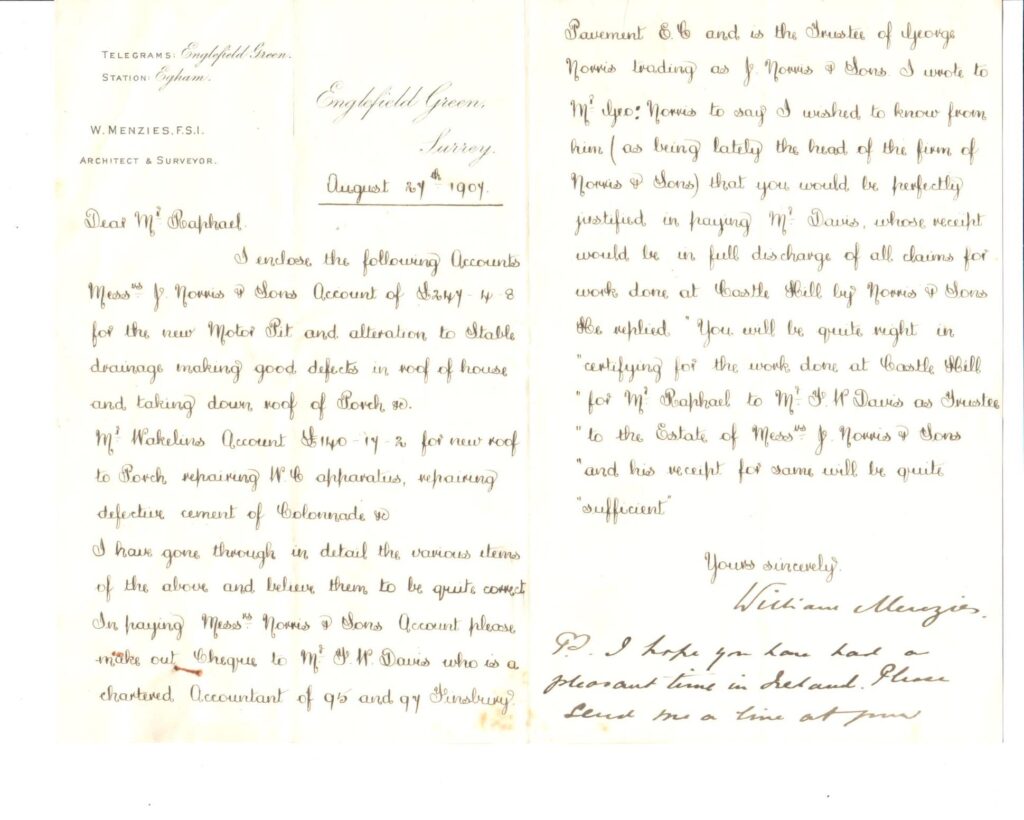
By 1913 he was also surveyor of highways to the Egham Urban District Council and to the Windsor Rural District Council.
William Kenneth became a boarder at Scaitcliffe School (now Bishopsgate School), presumably followed by Ronald Victor.
In 1904 William Jr published his own book “Windsor Park and Forest being a short history of the park and forest and a description of the most interesting features to be found there”, dedicating it to the memory of his late father. Much of it, including photographs, reproduced his father’s work “the trees having changed so little in character, the illustrations represent them practically as they are at the present day.”[v]
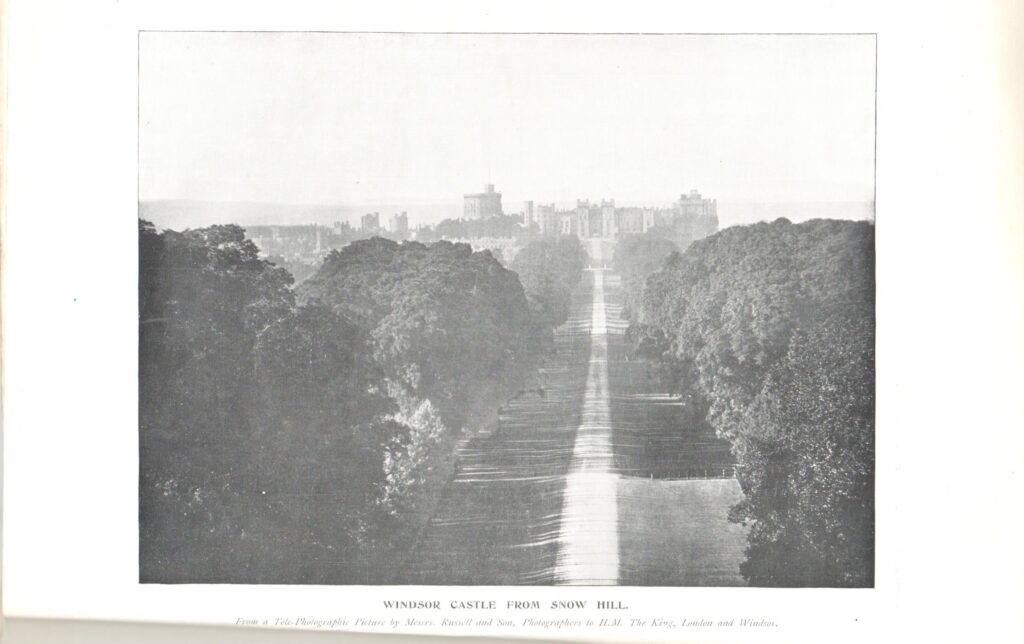
In 1927 he built a house in the grounds of Golspie, called Rannoch, later changed to Rough Acre. He then moved to a new house he had designed in Northcroft Road, which took the name Golspie, renaming the house on Middle Hill as Pentlands. Pentlands was demolished in 1970 making way for four neo-Georgian houses, one of which retained the name.
William Menzies Jr died in 1939, leaving his entire estate worth £14109 3s 5d (an impressive £1,155,756.54) to the younger son, Ronald Victor.
William Kenneth, a government valuer, married Winifred Peto at St Jude’s Church in 1912. They moved to Hunstanton in Norfolk and had a daughter Rosemary in 1914. However their marriage seems to have been a casualty of the First World War. William Kenneth joined the Royal Fusiliers, reaching the rank of Acting Sergeant, and should have been awarded the 1914-1915 Star but it was withheld in view of offences committed, including absences.
By 1918 he was apparently stationed with the King Edward’s Horse regiment in Dublin and Winifred had moved back to live with his parents in Golspie. In 1918 she filed successfully for divorce on the grounds that he had given her a sexually transmitted disease and had repeatedly committed adultery with a married woman called Alice Catherine Manners.
In 1919 William Kenneth married Alice, now divorced by her first husband Edward Manners who had retained custody of their daughter Alys, and they seem to have spent most of their married life in the Shoreham and Brighton areas. Interestingly he gave his house in Shoreham the name of Parkside. It is not clear how he earned his living during that period but in 1924, described as a traveller, he was brought to trial in Birmingham and imprisoned for twelve months for stealing an overcoat and mackintosh. During the 1930s he made frequent trips to Tangier asserting that he was of independent means but it seems hard to believe that he was not engaged in some sort of trade.
Estranged from his parents who left him nothing in their wills, he died in Brighton in 1957.
Ronald Victor followed family tradition by also becoming a surveyor. Following a stint in the army during World War I, rising to the rank of Captain, he went into partnership in 1923 with a Mr Hutchins who had been running an estate agent’s and auction business from 53 High Street (now Vape Xcel) since 1914. In 1925 Ronald took over as sole owner and moved the business to 47 High Street (now Nationwide). He seems to have given up the estate agency by 1935 to become a civil servant. Ronald married Patricia Constance Lacey in 1915 and they lived firstly at Golspie with his parents and later at Rannoch, the house built by his father, possibly specially for them. They had divorced by 1936 and he went to live in Staines with his second wife, Jessie Margaret Honess. Unlike William Kenneth’s, Ronald’s divorce does not seem to have affected his relationship with his parents. Eventually they moved to Holland Road, Kensington. Ronald died in 1969 in nearby Hammersmith.
Winifred and Rosemary Menzies spent the rest of their lives in the Englefield Green area, dying in 1966 and 2002 respectively.
General sources: Egham Museum photograph and document collections (including rate books), https://www.ancestry.co.uk, https://www.findmypast.co.uk
Dennis, Graham (1994) Englefield Green in Pictures. Egham: Egham by Runnymede Historical Society.
[i] Memoranda for His Royal Highness Prince Christian of Schleswig Holstein KG Ranger of Windsor Great Park, appointed 22nd June 1867. Extracted from different official papers by Major General F.H .Seymour, Deputy Ranger, October 1867 quoted in Roberts, Jane (1997) Royal landscape, the gardens and parks of Windsor, New Haven and London: Yale University Press, p.533
[ii] Menzies, William (1864) History of Windsor Great Park and Windsor Forest, with photographs by The Earl of Caithness & Mr. Bembridge [sic], of Windsor, Longmans
[iii] Additional publications by William Menzies listed in The red and white book of Menzies, a history of clan Menzies and its chiefs by D P Menzies 1894 pp499-500 Glasgow: Banks & Co; accessed 11 January 2024 at https://digital.nls.uk/histories-of-scottish-families/archive/96660448#?c=0&m=0&s=0&cv=10&xywh=0%2C-144%2C5049%2C3743
- “Present state of drainage,” by William Menzies, Deputy-Surveyor of Windsor Park and Forests to Her Majesty Queen Victoria. Published by Longmans, London, 1864-66.
- “Sanitary Management and Utilisation of Sewage,” by William Menzies, Deputy-Surveyor of Windsor Park and Forests to Her Majesty Queen Victoria. Published by Longmans, London, 1865.
- “Sanitary Management” (Additional Statement), by William Menzies, Deputy-Surveyor of Windsor Park and Forests to Her Majesty Queen Victoria. Published by Longmans, London, 1865
- “The Present State of the Drainage Question Considered,” by Wm. Menzies, Deputy-Surveyor of Windsor Park and Forests to Her Majesty Queen Victoria. Published by Longmans (?), London, 1866.
- “Suggestions for the Sanitary Improvement of Labourers’ Cottages and Villages,” by William Menzies, Deputy- Surveyor of Windsor Park and Forests to Her Majesty Queen Victoria. 8vo. Published by Longmans (?), London, 1869.
- “Forest Trees and Woodland Scenery, as Described in Ancient and Modern Poets” Illustrated in Chromo-Lithography. By William Menzies, Deputy-Surveyor of Windsor Park and Forests to Her Majesty Queen Victoria. Published by Longmans, London, 1875.
- “Drainage of Glasgow,” by William Menzies, Deputy-Surveyor of Windsor Park and Forests to Her Majesty Queen Victoria. Published by Clarke, Windsor, 1877.
[iv] The first incarnation of the environmental health inspector was the Inspector of Nuisances, tasked with patrolling poor neighbourhoods and looking into the issue of poor and insanitary housing.
[v] Menzies, William (1904) Windsor Park and Forest being a short history of the park and forest and a description of the most interesting features to be found there, Windsor; Oxley and Son

